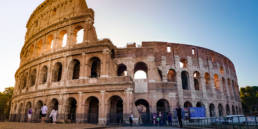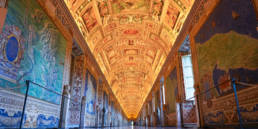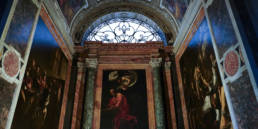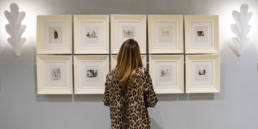The Borghese Gallery is one of the most exciting museums in Rome. It’s densely packed with sculpture and painting that represents a concentrated moment in time and one ruthless collector’s taste. It’s not a huge museum (only 20 rooms), but the quality of the works is so high that it’s easy to loose track of time, and that is a fatal error, for this museum has timed entry… and timed exit. You are only allowed 2 hours inside! In the past, I’ve visited on my own and gotten “stuck” in the Venetian Renaissance room, hence missing out on the Bernini and Caravaggio works that most people go to the Borghese to see.

This time I wanted to make sure I got a fuller view of the collection, so I booked the Borghese Gallery guided tour with Context Travel. This museum has six Caravaggios, which is the highest number of Caravaggio paintings in one single location in the world! It’s got three really important Bernini sculptures. There’s Titian, and Raphael. Artists to whom are dedicated whole semester-long graduate seminars – in the case of Caravaggio you could do a whole course on the paintings in that room. Paintings and sculptures that tell religious stories, but even more that recount mythological ones – not all of which we readily know. Having an expert guide in this museum is unquestionably the best way to see the main works, in detail, and to come out having actually learned something.
Borghese Gallery history
This is a museum begotten by nepotism, and its founder, Cardinal Scipione Borghese, gives definition to that term. Blogger and guide “The Pines of Rome” explains this best here:
“Rome, 16 May 1605. Camillo Borghese is elected Pope Paul V and immediately names his sister’s son, Scipione Caffarella, as Cardinal-Nephew. Not content with being a pope’s nephew, Scipione becomes the adopted son of his uncle and is known thereafter as Scipione Borghese. He became the most unscrupulous collector the art world has ever seen.
Scipione must have realized that as Cardinal-Nephew in corrupt 17th-century Rome, he would have more than ample access to any funds he might require, and so he traded his right of inheritance with his cousin Marcantonio, in exchange for every piece in the family’s art collection […and] used his power to satisfy his obsession to possess the world’s greatest art.”
He built the villa not as a Cardinal’s residence but as a place to keep all this great art. Modeled on country homes, it sits on the edge of a large park, and Scipione Borghese conceived it as a museum of the world, where art was shown head to head with botanical specimens, and artists would encounter and have interesting conversations. He did everything within his considerable power to make this happen, obtaining art by ruthless methods worthy of Sorrentino’s brilliant TV program “The Young Pope”. He didn’t even stop at stealing works from churches or jailing artists who refused to sell paintings to him.

Borghese Gallery what to see
All this ruthlessness has made for one excellent collection! If you’re a regular reader you know I’m mostly interested in Renaissance painting. I particularly love the Venetians (even if I’ve written about them rather little here – a peril of being based in Florence). I’m not a fan of the Baroque, and even less so of anything that comes after that and before the late 20th century. So this museum has a few things that excite me a lot, and a few that excite me a bit less. For example, our guide made it a point of spending time looking at a fresco made for Scipione Borghese by Cavalier d’Arpino (Giuseppe Cesari) in one of the main rooms as it cleverly refers to some of the works we’d see inside. Cesari was one of the chief artists in Rome in the day, working in the late Mannerist style, and he also possessed an important collection of paintings that the Cardinal wanted to get his paws on, but I think his painting is horrid and most certainly would have skipped over it myself.
In the risk of not doing the place justice, here is a short list of some of the most important works of art to see in the museum. I couldn’t possibly write about each in its full complexity, so encourage you to visit them in person as soon as you can, and to take a tour with a true expert in order to get the full story.
Raphael. Just leave me on the bench in front of his Deposition, which Scipione Borghese literally stole from a church in Perugia (and then had the Pope tell them it was a gift for his nephew, giving the poor Perugians no chance of ever seeing it again). This painting from 1507 fuses the best of Raphael’s colour and beauty (whom I’ve said sometimes I don’t like!) with the best of Michelangelo’s dynamism and physicality. Raphael had recently been in Florence and had observed Michelangelo and Leonardo’s work in the Salone dei 500 at Palazzo Vecchio. The movement of Leonardo’s battle is something he incorporates here, while Michelangelo gets a direct nod in the awkward rotating position of the woman at the base of the group on the right, who recalls the Doni Tondo. Preparatory drawings in the Louvre, Uffizi and London’s British Museum show that Raphael studied live models to get the right bodies and musculature, and that he struggled with the development of the most active possible way to render the composition. The result, in person, is quite stunning.
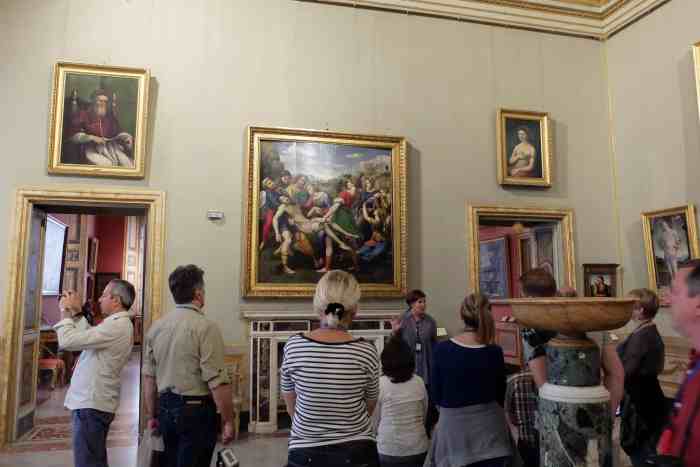
Titian. His Sacred and Profane love is definitely the blockbuster of the “Venetian Room” at the Borghese. People love to repeat the anecdote that the Rothchilds offered to pay a sum for this painting that was superior to the entire worth of the whole museum collection, buildings and grounds. This much studied painting is an allegory commissioned in 1513 to celebrate the marriage of Niccoló Aurelio, a secretary to the Council of Venice, to Laura Bagarotto. The most accepted interpretation is that it represents what its modern title says: two types of love. The Sacred on the right, nude and requiring no adornment, is put in contrast with the profane, represented in the made-up and bejewelled woman on the left. It’s a fun game to look through the landscape at the many elements, none of which are put there by chance.
A photo posted by Alexandra Korey (@arttrav) on
But don’t miss out on the other works in this room – sometimes the smaller and less famous ones can be even more joyful to behold. For me, it’s the Lorenzo Lotto that grabs my attention (A Madonna and Child with two saints), and next to it, a lovely little Madonna and Child in a landscape by Giovanni Bellini – two paintings that perhaps better encapsulate Venetian devotion of the first decade of the 16th century.

Caravaggio. One of the great things about Rome is that you can see his works in churches, for free, around the city (there’s also a lot of Caravaggio in Naples). But the Borghese is unique for the concentration of six works in one room! This artist was both loved and hated for his very realistic depiction of real models, often somewhat unseemly characters set in religious roles. But for all the lovingly depicted fruit and the very human figures, these paintings conceal so much more – both religious narratives, intensely represented, and the artist’s own fear of death. The St. John, the Madonna Palafrenieri, the Sick Bacchus, the David and Goliath… these are works that we feel we can instantly respond to, and that’s the power of Caravaggio.

Bernini. The great Baroque sculptor was only too happy to work quite exclusively for the Cardinal, and he produced three masterpieces for him (the museum also houses additional portrait busts by Bernini). Three rooms are given to, in chronological order, the Rape of Proserpine, the Apollo and Daphne, and his David. Seeing these works up close in person and taking the time to admire how masterfully Bernini transformed marble into the thinnest and most expressive of materials is worth the trip to Rome alone. This is one of those things that is just better seen in person.
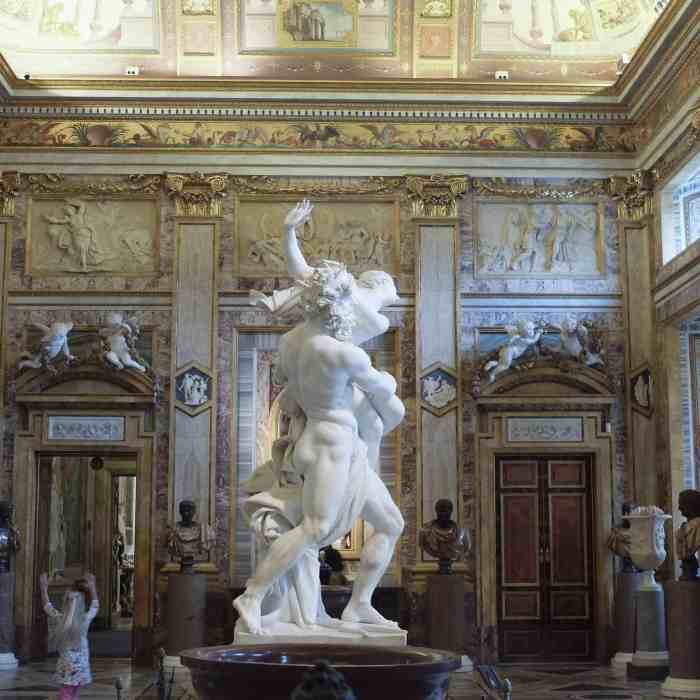
Our guide, Cecilia, pointed out details that I hadn’t seen before and showed us how Bernini evolved his technique as he worked on the three pieces. In the first, Bernini demonstrates his ability by the hand that presses into Proserpine’s soft flesh on her thigh, but I’d never noticed before the remarkable detail that he included armpit hair (on Pluto, not on her). In the second, the way that flesh turns to bark and leaves is a true feat that seems to play into the discourse of sculpture being more effective than painting, for it seems so real being life sized. In the third, detail gives way to force and power.

Borghese Gallery practical tips
How to get tickets: The museum is open daily except closed Mondays.
Reservations for your time slot are obligatory and can be purchased through the official website, though its usability is famously bad. Another option is to use Musement for all your Italy tickets and tours, a seamless system that also has numerous special offers and advantages.
As mentioned, if you’re not already very familiar with the collection, it could be a good idea to take a tour like Borghese Gallery guided tour with Context Travel. With max 6 people in a group, Context’s docents manage to weave you through the museum and get in front of the most important works ahead of the larger groups.
You need to arrive at the museum half an hour before your entry time in order to check all your worldly possessions (even a normal woman’s purse must be checked) and get in line to enter.
Most people enter from the outside, doing the ground floor and then the upper floor. Groups tend to invert the trend, and this might be a good idea for individuals as well. Enter from the underground area and take the stairs all the way up when you start.

How to get to Villa Borghese
From Rome’s train station, the Borghese is technically an easy bus ride away on the bus number 360 or 910. Although the schedule indicates that these run frequently, leave ample time for error. And by ample I mean 45 minutes to an hour spare time. (It took me an hour and 15 minutes to get there by bus when Google Maps indicated 23 minutes. The bus company is not reliable.) A taxi is the best option if you have to be on time – which you do due to the timed entry.
To see nearby: Quartiere Coppedè

While you’re in the area, rather than just dip in and out, a walk in the park is a perennial favourite. But another option is to go check out one of the most beautiful residential areas of Rome, just a short walk away. The Quartiere Coppedè is named after its architect Gino Coppedè, who designed the majority of its buildings in the second decade of the 1900s. The style is a fantastic interpretation of Liberty / Art Deco, and the concentration in just a few blocks makes you feel like you’ve stepped into a fairy tale. I have to thank my friend Linda of the very artsy ho(s)tel The Beehive for taking us to see this area last year! Not far from there is Villa Torlonia, in the same style, appreciable both from the inside (it’s a small museum) and from the outside. The residential area is home to numerous restaurants and bars that are not generally frequented by tourists – one I can recommend is the newly opened Bell Roma, a casual Bistrot that does pizza as well as more evolved dishes, live music and cocktail hour (it opens at 6:30pm, a good option after an afternoon of walking through museums!).
Sign up to receive future blog posts by email
Alexandra Korey
Alexandra Korey aka @arttrav on social media, is a Florence-based writer and digital consultant. Her blog, ArtTrav has been online since 2004.
Related Posts
April 9, 2019
A Restoration Lab Tour and Caravaggio in Rome
February 1, 2017

